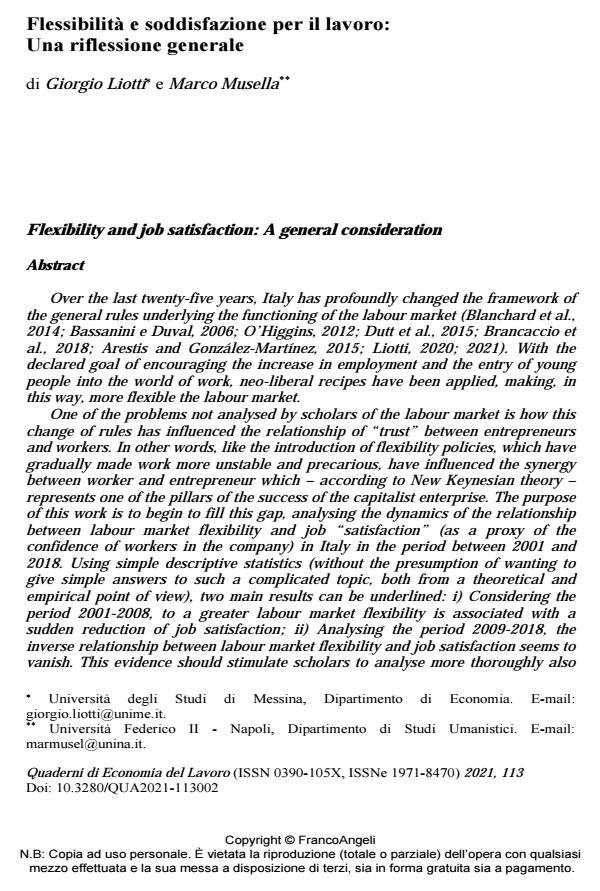Flexibility and job satisfaction: A general consideration
Journal title QUADERNI DI ECONOMIA DEL LAVORO
Author/s Giorgio Liotti, Marco Musella
Publishing Year 2022 Issue 2021/113
Language Italian Pages 15 P. 13-27 File size 356 KB
DOI 10.3280/QUA2021-113002
DOI is like a bar code for intellectual property: to have more infomation
click here
Below, you can see the article first page
If you want to buy this article in PDF format, you can do it, following the instructions to buy download credits

FrancoAngeli is member of Publishers International Linking Association, Inc (PILA), a not-for-profit association which run the CrossRef service enabling links to and from online scholarly content.
Over the last twenty-five years, Italy has profoundly changed the framework of the general rules underlying the functioning of the labour market (Blanchard et al., 2014; Bassanini e Duval, 2006; O’Higgins, 2012; Dutt et al., 2015; Brancaccio et al., 2018; Arestis and González-Martínez, 2015; Liotti, 2020; 2021). With the declared goal of encouraging the increase in employment and the entry of young people into the world of work, neo-liberal recipes have been applied, making, in this way, more flexible the labour market. One of the problems not analysed by scholars of the labour market is how this change of rules has influenced the relationship of "trust" between entrepreneurs and workers. In other words, like the introduction of flexibility policies, which have gradually made work more unstable and precarious, have influenced the synergy between worker and entrepreneur which - according to New Keynesian theory - represents one of the pillars of the success of the capitalist enterprise. The purpose of this work is to begin to fill this gap, analysing the dynamics of the relationship between labour market flexibility and job "satisfaction" (as a proxy of the confidence of workers in the company) in Italy in the period between 2001 and 2018. Using simple descriptive statistics (without the presumption of wanting to give simple answers to such a complicated topic, both from a theoretical and empirical point of view), two main results can be underlined: i) Considering the period 2001-2008, to a greater labour market flexibility is associated with a sudden reduction of job satisfaction; ii) Analysing the period 2009-2018, the inverse relationship between labour market flexibility and job satisfaction seems to vanish. This evidence should stimulate scholars to analyse more thoroughly also other issues related to flexibility: it is a question, for example, not only of studying in greater depth the abstract relationship between labour market flexibility and job satisfaction, but also of investigating the economic, social and political factors that are the basis of the dynamic change in the trend in the two different periods considered and, also, for example, to understand the impact on productivity.
Keywords: flexibility; labour market; job satisfaction.
Giorgio Liotti, Marco Musella, Flessibilità e soddisfazione per il lavoro: Una riflessione generale in "QUADERNI DI ECONOMIA DEL LAVORO" 113/2021, pp 13-27, DOI: 10.3280/QUA2021-113002